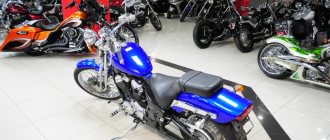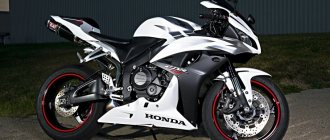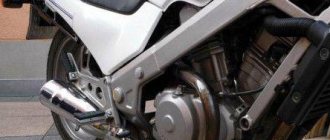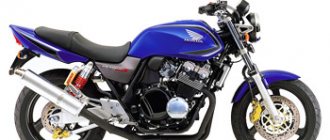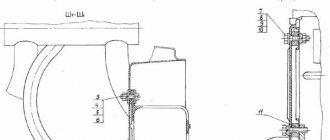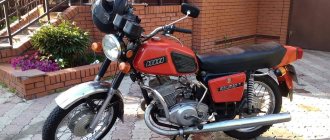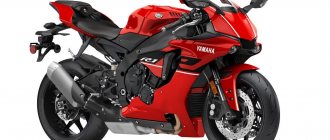Japanese motorcyclesHonda motorcycles
Honda Corporation is a world leader in the production of motorcycles, and the first company in Japan to put their production on an assembly line.
In 1975, the company's new motorcycle with an inline 4-cylinder mid-volume engine was presented to the public - the CB400F, a lighter version of the legendary CB750.
The air-cooled engine had 2 valves per cylinder and developed 37 hp. The motorcycle was equipped with front disc and rear drum brakes, and the weight of the motorcycle was 182 kg. It was the first-born in the CB400 series.
Advantages and disadvantages
The Honda CB 400, whose technical characteristics were something fantastic for classic motorcycles in the early 90s, continues to delight its owners with the following advantages:
- Reliability of the engine and transmission, which have been tested over the years;
- Quick acceleration to cruising speed (120-130 km/h) and then to maximum speed (190 km/h);
- Excellent dynamics - 4.5 seconds to hundreds;
- Suitable dimensions for comfortable movement on busy city roads;
- The constant availability of spare parts on the market allows you to save on bike maintenance, and besides, they themselves are inexpensive;
- Moderate fuel consumption: compared to the Suzuki GSF 400 Bandit, which consumes up to 8 liters per 100 km, the Honda can swallow no more than 6;
- Excellent for girls and beginner motorcyclists as a first car due to its good handling and low weight.
The motorcycle has a conservative design.
It is not without its drawbacks:
- Conservative design isn't everyone's cup of tea;
- The front fork is quite soft;
- On older Hondas, the relay regulator regularly fails.
Production
The motorcycle was produced from 1988 to 1999, which in itself speaks of its popularity. However, even after so many years, it continues to remain very relevant, especially if a person does not have much money, but the desire to purchase at least some kind of sports bike is enormous.
Technical characteristics of CBR400 R on nc23 frame
CBR400 Aero / CBR400 RRK
| Specifications/Models | CBR400RG (Aero) | CBR400 RH-Ya (Aero) | CBR400RRJ | CBR400RRK |
| Year of issue | 1986 | 1987 | 1988 | 1989 |
| Frame number from... / to... | NC23-1000027 | NC23-1015001 | NC23-1020011 | NC23-1090001 |
| NC23-1010690 | NC23-1016160 | NC23-1036454 | NC23-1098116 | |
| Engine number from... / to... | NC23E-1000042 | NC23E-1015002 | NC23E-1020001 | NC23E-1090001 |
| NC23E-1010736 | NC23E-1016192 | NC23E-1036510 | NC23E-1098123 | |
| Carburetor | VG02A-A | VG02A-E | VG04A-A | VG04B-A |
| L × W × H (mm) | 2015 × 685 × 1095 | 2020 × 690 × 1110 | ← | |
| Wheelbase (mm) | 1380 | 1370 | ← | |
| Ground clearance (mm) | 140 | 120 | ← | |
| Seat height (mm) | 765 | 765 | ← | |
| Weight / Dry weight (kg) | 184 / 165 | 179 / 162 | ← | |
| Engine capacity (cm3) | 399 | ← | ← | ← |
| Fuel consumption (km/l) | 43 (~60 km/h) | 38.1 (~60 km/h) | ← | |
| Diam. cylinder × piston stroke | 55 × 42 (mm) | ← | ← | ← |
| Compression ratio | 11:1 | 11.3:1 | ← | |
| Max. power (hp/rpm) | 59 / 12 500 | 59 / 12 500 | ← | |
| Max. torque (Nm/rpm) | 3.8 / 10 000 | 4 / 10 000 | ← | |
| Gas tank volume (l) | 16 | ← | 15 | ← |
| Gearbox (stages) | 6 | ← | ← | ← |
| Gearbox ratios: | ||||
| 1 | 3,307 | ← | ||
| 2 | 2,352 | ← | ||
| 3 | 1,875 | ← | ||
| 4 | 1,590 | ← | ||
| 5 | 1,434 | ← | ||
| 6 | 1,280 | ← | ||
| Suspension: | ||||
| Front fork | Telescopic, air-oil. Made by Showa | ← | ← | |
| Fork diameter (mm) | 41 | ← | ||
| Rear swingarm | Tri-Arm | ← | ||
| Brakes, number of pistons: | ||||
| Before | 2 | ← | ← | ← |
| Back | 1 | ← | ← | ← |
| Brakes, disc diameter (mm): | ||||
| Before | 275 | ← | ||
| Back | 220 | ← | ← | ← |
| Caster* / Track (mm) | 25° 15´/ 95 | ← | ||
| Tire sizes: | ||||
| Before | 100/80 R17 52H | ← | 120/60 R17 55H | ← |
| Back | 130/70 R18 63H | ← | 150/60 R18 67H | ← |
| Colors | Shasta white/red | Pearl crystal white/purple | Granite blue/black | Granite blue/silver |
| Shasta white/purple | Terra blue/white/red | Terra blue/white/red | ||
| Granite blue/silver | Seychelle night blue/white | Pearl crystal white/purple | ||
* Caster is the angle of inclination of the turning axis
Technical specifications of CBR400 RR on nc29 frame
CBR400 RRN / CBR400 RRR
| Specifications/Models | CBR400 RRL | CBR400 RRN | CBR400 RRR | |
| Year of issue | 1990 | 1992 | 1994 | |
| Frame number from... ~ to... | NC29-1000001 | NC29-1050001 | NC29-1100001 | |
| NC29-1010598 | … | … | ||
| Engine number from... / to... | NC23E-1300001 | NC23E-1420001 | NC23E-1500001 | |
| NC23E-1310636 | … | … | ||
| Carburetor | VP01A-A | VP01A-B | VP01B-A | |
| L × W × H (mm) | 1990 × 670 × 1080 | ← | ← | |
| Wheelbase (mm) | 1365 | ← | ← | |
| Ground clearance (mm) | 125 | ← | ← | |
| Seat height (mm) | 750 | ← | ← | |
| Weight / Dry weight (kg) | 179 / 162 | ← | 180 / 163 | |
| Engine capacity (cm3) | 399 | ← | ← | |
| Fuel consumption (km/l) | 35 (~60 km/h) | ← | 32 (~60 km/h) | |
| Diam. cylinder × piston stroke | 55 × 42 (mm) | ← | ← | |
| Compression ratio | 11.3:1 | ← | ← | |
| Max. power (hp/rpm) | 59 / 13 000 | ← | 53 / 13 000 | |
| Max. torque (Nm/rpm) | 4 / 10 000 | ← | 3.6 / 10 000 | |
| Gas tank volume (l) | 15 | ← | ← | |
| Gearbox (stages) | 6 | ← | ← | |
| Gearbox ratios: | ||||
| 1 | 3,307 | ← | ← | |
| 2 | 2,352 | ← | ← | |
| 3 | 1,875 | ← | ← | |
| 4 | 1,590 | ← | 1,578 | |
| 5 | 1,434 | ← | ← | |
| 6 | 1,318 | ← | ← | |
| Gear ratio | 2.117 / 2.600 | ← | ← | |
| Suspension: | ||||
| Front fork | Telescopic, air-oil. Made by Showa | ← | ||
| Fork diameter (mm) | 41 | ← | ← | |
| Rear swingarm | Gull-Arm | ← | ← | |
| Brakes, number of pistons: | ||||
| Before | 2 | ← | ← | |
| Back | 1 | ← | ← | |
| Caster* / Track (mm) | 24° 30´ / 91 | ← | ← | |
| Tire sizes: | ||||
| Before | 120/60 R17 55H | ← | ← | |
| Back | 150/60 R17 66H | ← | ← | |
| Colors | Fighting red/Pearl crystal white | Pearl crystal white/Dionysus blue | Ross white/Jockey blue | |
| Granite blue/Light silver | Pure black | Sparkle pearl black/Procyon red | ||
| Passion red/Heavy gray | ||||
| Granite blue/Heavy gray | ||||
* Caster is the angle of inclination of the turning axis
Description and features of the motorcycle
The Honda SB 400 continues to meet the demands of motorcyclists to this day. Sufficient power combined with moderate fuel consumption make the bike in demand.
Not to mention the appearance, which lovers of the classics will definitely appreciate.
Design
The 1992 Honda received a steel duplex frame and a double rear shock absorber. The fuel tank remains the same classic shape as on the CB-1, but the new model has a single handlebar. According to modern classification, the bike is a naked bike.
Make the bike in demand to meet the requirements of motorcyclists
Weight and dimensions
The length of the motorcycle is 205 cm, width 72.5, and height 107. How much a Honda motorcycle weighs depends on the modification. The CB400 NC39 weighs 168 kg. The dry weight of the NC42 is 170 kg, and the NC31 is 173.
The problem of choosing the first motorcycle (CB400 or new Chinese) is NOT CHINESE
I invite everyone to help me choose my first motorcycle. Not to inflame the Chinese people, but to clarify some points. To begin with, the introductory data: 27 years old, height 186, experience category “B” (real, not in crusts) - 9 years and a lap of 3 in kilometers. I live in Chelyabinsk. I passed category “A” in the fall (I managed to do it through self-study). Experience - 0 km. Mileage on the ebre on the site does not count. Before that, I rode a motorcycle (planet-sport) twice ten years ago - one of them as a passenger. It took me a long time to think about a motorcycle (these thoughts more or less took shape three years ago in the desire to take a 70 cc Alfa and ride like a scooter; I didn’t want to bother with a license). In the end, everything resulted in passing the exam, opening category A, and thinking about something more interesting and pleasant than alpha. For the last three months I haven’t been able to figure out what I should buy (what I will buy is a settled question), but what exactly is an open question. I was looking at stealth guns (in particular flex 250) and the taker cartridge. Recently I started noticing advertisements on Avito about the sale of CB400 for reasonable money. My budget is around 100,000 rubles (plus or minus 10%). + equipment separately. I know one thing: my first motorcycle will be a road bike. I like choppers, but they're not my thing yet. Sports - absolutely not. I don’t like the look at all (in my budget), and I got caught up in turbo Subars in my youth. Enduro, maybe, but most of all I’m inclined towards road builders. I figured out for myself the pros and cons of each option (in my Dummies opinion): Pros of a Honda: 1 It’s a Honda 2 A common motorcycle, studied, the sores are mostly known 3 More powerful than the Chinese for the same price (sometimes I would like to drive 100-150 km away from the city along the highway) 4 As far as I understand, it’s easy to drive for a beginner Cons of the Honda: 1 Age (general condition of the motorcycle, I don’t think I can afford a polished CB400 in my budget) 2 Surely, the price of spare parts and service is much higher than that of the Chinese 3 There is no guarantee (and I won’t be able to choose the first motorcycle myself, since I have 0 experience, I can, in theory, grab a crooked and overcooked and killed engine) 4 Slightly more expensive insurance and taxAdvantages of the Chinese: 1 Price 2 New, no guarantee 3 Spare parts cost pennies 4 Taxes, insurance - almost free 5 Easy to drive for a beginner Cons of the Chinese: 1 It’s not clear what’s wrong with the quality, and the warranty is only a year 2 The engines are half-dead (maximum 25-30 horses for the taker, and it’s not clear which ones, it may not be enough for the track) 3 Selling later is unrealistic Hence a number of questions for respected experts: 1 Cost of consumables and spare parts for a Honda, approximate cost of ownership per year 2 Necessity/uselessness of 40 horses in the city (on the track they are never superfluous) 3 Cost serious repairs of the Honda (engine, gearbox) in case something happens And to catch up, if there is anyone from Chelyabinsk, maybe in the future, for a fee, would agree to help with the choice of engine, if I am inclined to the Japanese version?
Specifications
The saleability of the motorcycle is explained by its technical indicators.
Engine capacity
Honda SB 400 four-stroke engine with four cylinders with a total displacement of 399 cc. cm is considered the main feature of Honda, which began production in 1992.
Transmission
The Honda is equipped with a 6-speed gearbox with a chain drive.
Chassis and brakes
The steel tubular frame provides fastening of the main components of the motorcycle. The brakes are installed on the Honda.
Honda CB400 has been modified several times
Fuel consumption
Depending on driving style, consumption may vary, but is usually 4-6 liters per 100 km.
Air filter
Motorcycles on the NC31 frame are equipped with filters with a round profile, and those that began to be produced in 1999 (VTEC) are equipped with an oval one. The Honda SB 400 filter needs to be changed every 12,000 km. On Hondas produced from 1992-1998, the gas tank must be removed to replace it.
Brief history of the model
- 1988 - start of production and sales of the Honda CBR 400 RR model, which replaced the Honda CBR 400 R Aero. This year's models have the Hurricane prefix on the lower side plastic. The first generation of the motorcycle. The frame number is NC23. The full model name is CBR400RR-J.
- 1989 - full model name - CBR400RR-K. The Hurricane prefix is removed from the plastic.
- 1990-1991 - second generation of the motorcycle. The frame number is NC29. The full model name is CBR400RR-L.
- 1992-1993 — full model name — CBR400RR-N.
- 1994 - full model name - CBR400RR-R. Starting this year, the model receives the Fireblade prefix at the top of the side plastic.
- 1999 is the last year of production of the Honda CBR 400 RR.
Modification and hybrids
The Honda CB400 has been modified several times. Version-R and VTEC upgrades have become especially widespread.
Honda CB 400
Since 1992, the Honda cv400 motorcycle, already in its basic classic configuration, has become an object of fantasy for both beginners and experienced motorcyclists.
СB 400 Super Four Version-R
This modification differed from the usual Honda SB 400 by the presence of a built-in plastic fairing and a square headlight.
Honda CB 400 Super Four Version-R
CB 400 Super Four VTEC
Since 1999, motorcycles have been equipped with a HYPER VTEC system, which regulates the operation of engine valves. At 6750 rpm and less, 8 valves worked, if the rpm was higher, then 8 more were turned on. This improved traction at low speeds and made it possible to get the desired “pickup” at the top. Fuel consumption has also decreased and performance has increased. The Honda SB 400 VTEK 3 successfully competes with more modern motorcycles on the roads.
Consumables for CB 400 SF.
| Battery | Yuasa YTX9BS |
| Oil filter | HM 15410-MM9-PO1 (Honda) HIF HF303 (HI-Flo Filters) |
| Air filter | HM MY9K1 (Honda) Champion J301 HFA 1402 (Hi-Flo Filters) |
| Front tire | Bridgestone BT 45 |
| Rear tire | Bridgestone BT 45 |
| Brake fluid | DOT 4 |
| Front brake pads | FA142 – Kevlar (EBC Brakes) FA142HH – Grooved (EBC Brakes) BB-H030 (Brembo) Sport Compound BB-H030RR (Brembo) Racing Compound FD-B570SS (Ferodo) Supersport 2р-202 (Nissin) FD-B533P(Ferodo)- for CB400SF from '96 (CBR900RR). VD-156 (Vesrah) p188 (Premier) SBS 627 MCB 598 (Lucas) |
| Rear brake pads | BB-H027 (Brembo) Sport Compound BB-H027RR (Brembo) Racing Compound FERODO FDB531 599/599LF (Lucas) 2p-204 (Nissin) |
| Front right disc | FA1132RS (EBC Brakes) |
| Front left disc | FA1132LS (EBC Brakes) |
| Front brake cylinder | MSB 102 |
| Rear shock absorbers | F10.29.7610-1512 (KONI) |
| Rear disc | FA1020 (EBC Brakes) |
| Clutch | CK1228 (EBC Brakes) |
| Clutch spring | CSK6 (EBC Brakes) |
| Candles | NGK CR8EH9,CR9EH9. |
| Fork seals | 41x54x11 Honda 51490-mn8-305 oil seal, boot 51415-mm8-003 upper guide 51414-mn5-003 lower guide Vesrah 4102 (set of oil seals + boots) |
| Relay regulator | 31600-MV4-010 |
| Headlight bulb | H4 60/65W |
Maintenance of CB 400 SF.
P-check C-replace
| kilometers *1000 | 1 | 6 | 12 | 18 | 24 | 30 | 36 |
| Checking the fuel system | P | P | P | ||||
| Gas control | P | P | P | ||||
| Suction | P | P | P | ||||
| Air filter | Z | Z | Z | ||||
| Candles | Z | Z | Z | Z | Z | Z | |
| Valve clearances | P | P | |||||
| Engine oil | Z | Z | Z | Z | Z | Z | |
| Oil filter | Z | Z | Z | Z | Z | Z | |
| Carburetor synchronization | P | ||||||
| Idle speed | P | P | P | P | P | P | P |
| Coolant | Z | Z | Z | ||||
| Cooling system | P | P | P | ||||
| Chain | Lubricate every 500 km, wash every 1500 km. | ||||||
| Brake fluid | Z | P | Z | P | Z | ||
| Brake system | P | P | P | P | P | P | |
| Brake pads | P | P | P | P | P | P | |
| Brake light switch | P | P | P | P | P | P | |
| headlight | P | P | P | ||||
| Clutch | P | P | P | P | P | P | |
| Side stand | P | P | P | ||||
| Suspension | P | P | P | ||||
| Nuts/Bolts/Latches | P | P | P | P | P | P | |
| Wheels/Tires | P | P | P | P | P | P |
Choice of oil.
| Ambient temperature | Oil viscosity |
| 0 / +50 C | SAE 20W50 |
| 0 / +40 C | SAE 20W50 |
| -15 / +40 C | SAE 10W40 |
| -15 / +32 C | SAE 10W30 |
Negative qualities
In addition to the advantages, the motorcycle also has a number of disadvantages, including:
- Difficulties in replacing parts - often they have to be ordered from private sellers from abroad, spending a lot of money.
- It is almost impossible to find a CB-1 motorcycle in good condition.
- Some motorcyclists believe that this model has too capricious carburetors that need to be synchronized and often cleaned.
- Sometimes, when the motorcycle is tilted strongly, the muffler may cling to the road surface.
- Significant gas consumption with a small fuel tank will force you to stop at gas stations frequently.
